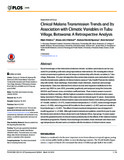Please use this identifier to cite or link to this item:
http://hdl.handle.net/10311/1441Full metadata record
| DC Field | Value | Language |
|---|---|---|
| dc.contributor.author | Chirebvu, Elijah | - |
| dc.contributor.author | Chimbari, Moses John | - |
| dc.contributor.author | Ngwenya, Barbara Ntombi | - |
| dc.contributor.author | Sartorius, Benn | - |
| dc.date.accessioned | 2016-06-30T13:01:37Z | - |
| dc.date.available | 2016-06-30T13:01:37Z | - |
| dc.date.issued | 2016-03-16 | - |
| dc.identifier.citation | Chirebvu, E. et al (2016) Clinical malaria transmission trends and Its association with climatic variables in Tubu village, Botswana: A retrospective analysis. (2016) Plos One, Vol.11, No. 3, pp. 1-16 | en_US |
| dc.identifier.issn | 1932-6203 (Online) | - |
| dc.identifier.uri | http://hdl.handle.net/10311/1441 | - |
| dc.description.abstract | Good knowledge on the interactions between climatic variables and malaria can be very useful for predicting outbreaks and preparedness interventions. We investigated clinical malaria transmission patterns and its temporal relationship with climatic variables in Tubu village, Botswana. A 5-year retrospective time series data analysis was conducted to determine the transmission patterns of clinical malaria cases at Tubu Health Post and its relationship with rainfall, flood discharge, flood extent, mean minimum, maximum and average temperatures. Data was obtained from clinical records and respective institutions for the period July 2005 to June 2010, presented graphically and analysed using the Univariate ANOVA and Pearson cross-correlation coefficient tests. Peak malaria season occurred between October and May with the highest cumulative incidence of clinical malaria cases being recorded in February. Most of the cases were individuals aged >5 years. Associations between the incidence of clinical malaria cases and several factors were strong at lag periods of 1 month; rainfall (r = 0.417), mean minimum temperature (r = 0.537), mean average temperature (r = 0.493); and at lag period of 6 months for flood extent (r = 0.467) and zero month for flood discharge (r = 0.497). The effect of mean maximum temperature was strongest at 2-month lag period (r = 0.328). Although malaria transmission patterns varied from year to year the trends were similar to those observed in sub-Saharan Africa. Age group >5 years experienced the greatest burden of clinical malaria probably due to the effects of the national malaria elimination programme. Rainfall, flood discharge and extent, mean minimum and mean average temperatures showed some correlation with the incidence of clinical malaria cases. | en_US |
| dc.description.sponsorship | This work was supported by International Development Centre, Canada. Grant Number: 106024-001 (MJC). | en_US |
| dc.language.iso | en | en_US |
| dc.publisher | Plos One, http://journals.plos.org/plosone/ | en_US |
| dc.rights | This is an open access article distributed under the Creative Commons Attribution License, which permits unrestricted use, distribution, and reproduction in any medium, provided the original work is properly cited. | en_US |
| dc.subject | Malaria | en_US |
| dc.subject | malaria transmission | en_US |
| dc.subject | flood | en_US |
| dc.subject | transmission trends | en_US |
| dc.title | Clinical malaria transmission trends and Its association with climatic variables in Tubu village, Botswana: A retrospective analysis | en_US |
| dc.type | Published Article | en_US |
| dc.rights.holder | The authors | en_US |
| dc.link | http://www.ncbi.nlm.nih.gov/pubmed/26983035 | en_US |
| Appears in Collections: | Research articles (ORI) | |
Files in This Item:
| File | Description | Size | Format | |
|---|---|---|---|---|
| Chirebvu_ MRT_2015.pdf | Main Article | 970.8 kB | Adobe PDF |  View/Open |
Items in DSpace are protected by copyright, with all rights reserved, unless otherwise indicated.
